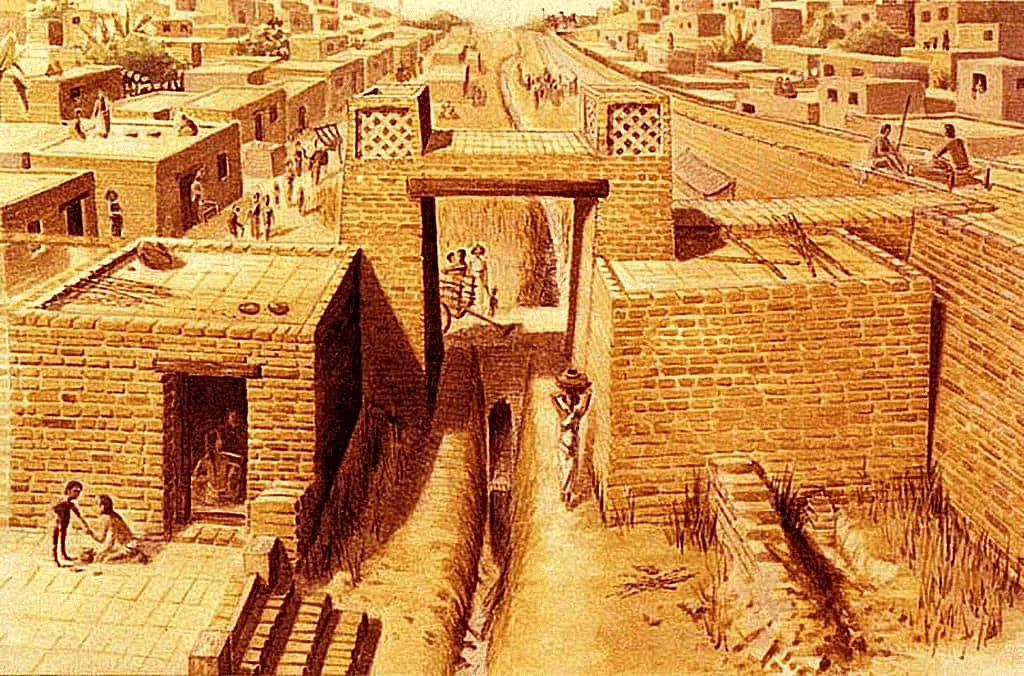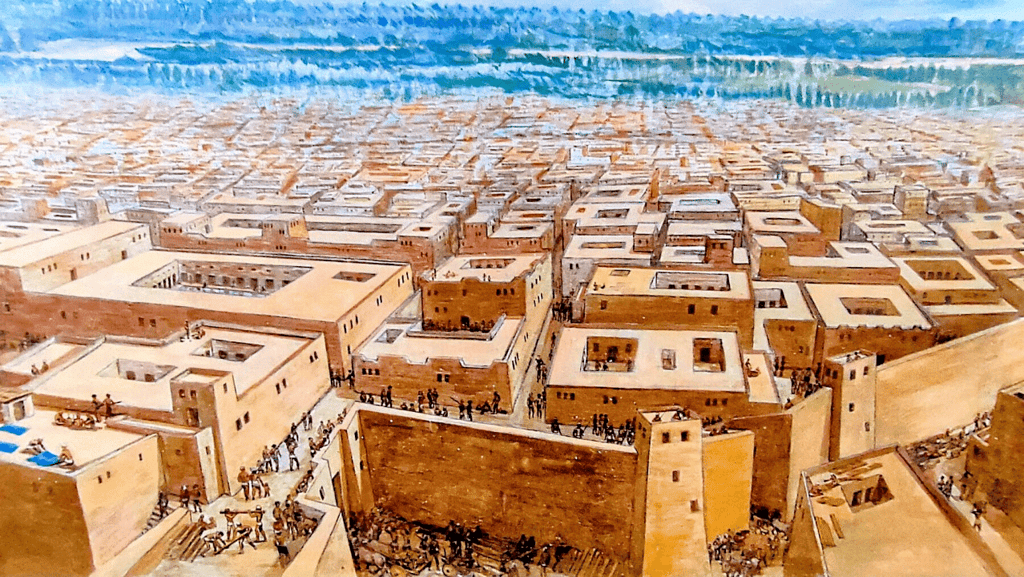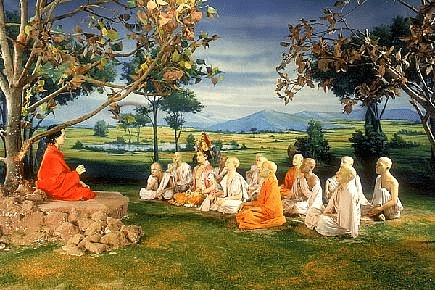Notes: The First Cities | Social Studies & Pedagogy Paper 2 for CTET & TET Exams - CTET & State TET PDF Download
The Indus Valley Civilisation was an ancient civilisation in the Indian sub-continent. It was a bronze age civilisation, extending from North-East Afghanistan to Pakistan and North-West India. Along with ancient Egypt and Mesopotamia, Indus Valley Civilisation was one of the three early civilisations of ancient world. This civilisation is also known as Harappan civilisation.

Discovery of Harappa
The ruins of Harappa were initially documented by Charles Masson in 1842. General Alexander Cunningham visited the site in 1856 during the construction of the East Indian Railway connecting Karachi and Lahore. The first excavations at Harappan sites were conducted by Sir John Marshall in 1921.
Characteristics of Harappan Civilization
- The Indus Valley Civilization extended into regions such as Manda (Jammu and Kashmir), Daimabad (Maharashtra), Alamgirpur (Uttar Pradesh), and Sutkagendor (Afghanistan).
- Harappan cities were located in Punjab, Sind Province, Gujarat, Rajasthan, Haryana, Western Uttar Pradesh, Baluchistan, and Afghanistan.
- Many cities were divided into citadel (western part) and lower town (eastern part), with walls of baked brick surrounding each section in an interlocking pattern.
Social Conditions
- Harappan cities were bustling centers possibly with a matriarchal society where rulers oversaw important constructions.
- Rulers dispatched expeditions to acquire metals, precious stones, and other resources from distant lands.

Social Structure
- Merchants held a prominent position in society, alongside laborers, farmers, craftsmen, doctors, priests, and officers. Evidence suggests the existence of a slavery system.
- Diet included both vegetarian and non-vegetarian items like wheat, barley, lemon, fish, mutton, beef, poultry, and pork.
- Both men and women adorned themselves with ornaments such as necklaces, finger-rings, earrings, bangles, bracelets, and anklets.
- Leisure activities included dancing, singing, fishing, and gaming, with gambling being a popular pastime among elder men.
City Life: Infrastructure
- Houses were typically one or two stories high, built around courtyards, with separate bathing areas and sometimes wells for water supply.
- An impressive drainage system directed water from houses to street drains, constructed with mortar, lime, gypsum, and covered with brick or stone slabs, showcasing advanced sanitation practices.
- Town planning featured a grid system with streets intersecting at right angles, dividing towns into large rectangular blocks.
New Crafts in the City
- Archaeological finds include items crafted from stones, shells, and metals like copper, bronze, gold, and silver.
- Copper and bronze were utilized for tools, weapons, ornaments, and vessels, while gold and silver were primarily used for ornaments and vessels.
- Notable discoveries include beads, weights, blades, stone seals often featuring carved animals, and pots adorned with black designs.
- Early evidence of cotton cultivation exists, with cloth remnants found at Mohenjodaro and terracotta spindle whorls used for spinning thread.
- Faience, an artificially produced material, was used to create beads, bangles, earrings, and vessels, glazed in blue or sea green colors.
Trade and Commerce
- Harappans were engaged in various crafts such as stone-cutting, bead polishing, seal carving, metallurgy, and ivory work, with evidence suggesting a developed ship industry.
- Trade goods included agricultural products, cotton goods, terracotta figurines, pottery, certain beads, conch shells, and ivory products.
- The Sumerians referred to the Indus Valley Civilization as Meluha and mentioned two intermediate stations, Dilmun and Makan.
- Indus Valley seals have been discovered in Mesopotamian towns like Ur, Kish, and Susa.
Agriculture
- Agriculture formed the foundation of the civilization, benefiting from fertile soil due to Indus River inundation and flooding.
- Techniques included wooden plowshares and stone sickles for harvesting, along with gabarbands or nalas enclosed by dams for water storage in parts of Baluchistan.
- Main crops cultivated were wheat, barley, dates, peas, sesamum, mustard, millet, ragi, bajra, and jowar.
Religious Practices
- Terracotta figures depict a Mother Goddess symbolizing fertility with a plant growing from a woman's embryo.
- Pashupati Mahadeva, a proto-Shiva, is represented in seals seated in a yogic posture with three faces, two horns, and surrounded by various animals.
Mohenjodaro

- Discovered in 1922 by RD Bannerjee, Mohenjodaro is one of the largest sites located on the river Indus. Its name translates to "mound of the dead" in Sindhi.
- Notable structures include a multi-pillared assembly hall and a rectangular building possibly serving administrative functions.
- The Great Bath, a significant public area, was used for bathing with steps leading to the surface, changing rooms, and inlet and outlet for water. Its dimensions were 39 feet (length), 23 feet (breadth), and 8 feet (depth).
- Artifacts found include Pashupati seals, a bronze image of a dancing girl, cylindrical seals, a steatite image of a bearded man, clay figurines of mother Goddess, dice, a yogi idol, and a granary.
Lothal
- Located near the river Bhargava, Lothal is a prominent city of the Indus Valley Civilization.
- It features the only artificial brick dockyard among Indus sites and evidence of early rice usage and fire altars.
- Lothal has yielded the largest number of seals and granary discoveries.
Kalibanga
- Meaning "black bangles," Kalibanga is situated in Rajasthan and exhibits both proto-Harappan and Harappan cultural phases.
- The proto-Harappan phase saw ploughed fields and the discovery of platforms with five altars.
Dholavira
- Situated in the Rann of Kutch region of Gujarat, Dholavira was divided into three parts.
- Notable discoveries include Harappan writing, significant findings in one of the side rooms of the Northern Gateway, and evidence of urban planning.
The End of Harappan Civilization
Around 3900 years ago, a major change marked the decline of the Indus Valley Civilization. Many cities were abandoned, and writing, seals, and weights ceased to be used. Archaeologists propose several reasons for this decline:
- Possible drying up of rivers.
- Deforestation, likely due to the demand for wood in brick-making and copper smelting.
- Destruction of green cover by large herds of cattle, sheep, and goats.
- Floods in certain areas that may have led to the displacement of populations.
The Vedic Age

The history of Vedic India is primarily known through its religious texts, the Vedas, which provide insights into the political, social, and economic aspects of the period.
The Rig Veda, the oldest literary work in the Indo-European tradition, presents a glimpse of the simple socio-economic, political, and religious life of the Vedic people.
Early Vedic Period
- According to the Rig Veda, the Aryans were aware of the Indus Valley (Saptasindhava), with the Indus River being frequently mentioned. The Saraswati River (Naditarna) held special significance, identified as the Hakra Ghaggar channel in Haryana and Rajasthan.
- The term "Samudra" referred to a collection of water, not necessarily the sea. The Aryans had knowledge of geographical features like the Himavat (snow mountain) and Majuvant, the source of Soma, an intoxicating drink.
Later Vedic Period
- The Aryans settled in the upper Gangetic Doab and expanded eastward into areas like Videha, as depicted in the story of Videha Madhava in the Satapatha Brahmana.
- The later Vedas divide India into three main regions: Aryavarta (Northern India), Madhyadesa (Central India), and Dakshina Patha (Southern India).
The Vedas
The term "Veda," derived from the root word "Vid" meaning "to know," signifies knowledge par excellence. The Vedas comprise hymns, prayers, charms, and sacrificial formulas.
The Vedas, regarded as Apaursheya (not made by man) and Nitya (existing in all eternity), provide a comprehensive insight into the political, religious, social, and economic aspects of the Vedic period. They are attributed to inspired saints known as Rishis or Mantradrashtas, who received them directly from the supreme creator.
The Four Vedas
Rig Veda
- The oldest Veda, composed around 3500 years ago, emphasizes deities like Agni, Indra, and Soma.
- It comprises 1028 hymns divided into ten Mandalas (books), with Mandalas II to VII being the oldest.
- Mandalas VIII and IX belong to a later period, while Mandalas I and X are the last to be compiled.
- Notable hymns include the Gayatri Mantra in Mandala III and the Purushasukta hymn in Mandala X.
- Language: Old or Vedic Sanskrit, distinct from classical Sanskrit.
Sama Veda
- A collection of hymns mainly taken from the Rig Veda and set to music for chanting.
- Known as the Book of Chants and considered the origin of Indian music.
- Intended to be sung during Soma sacrifices by Udgatri priests.
Yajur Veda
- Prescribes rituals for various sacrifices, primarily for use by Adhvaryu priests.
- Presented in both verse and prose, with two versions: Krishna Yajur Veda (Black) and Shukla Yajur Veda (White).
- Mentions royal ceremonies like Rajasuya and Vajapeya.
Atharva Veda
- Contains charms and spells to ward off evils and diseases, reflecting non-Aryan influences.
- Consists of 731 hymns and contributes to Indian medical science (Ayurveda).
Other Vedic Texts
- Brahmanas: Elaborate commentaries on the Vedas, providing insights into sacrificial ceremonies. The Shatapatha Brahmana is the most important.
- Aranyakas: Known as forest books, they delve into mysticism and symbolism of sacrifice and priestly philosophy.
- Upanishads: These philosophical texts focus on spiritual teachings received from gurus.
The Vedangas
The period after 600 BC, known as the Sutra period, saw the compilation of the Vedangas, considered Smriti or literature handed down by tradition. There are six Vedangas:
- Shiksha (Phonetics)
- Chandas (Prosody)
- Vyakarana (Grammar)
- Nirukta (Etymology)
- Kalpa (Ritual)
- Jyotisha (Astronomy)
Social Life of the Vedic Period
- The Vedic society was tribal, with kingship as the foundation. Individuals were identified with their tribes or Jana, further divided into Vis (groups of villages), Gramas (villages), and Kulas (families).
- Social classes included priests, warriors, and commoners. Shudra, mentioned in later additions to the Rig Veda, indicates the presence of slavery.
- The division into four Varnas (Brahmanas, Kshatriyas, Vaishyas, and Shudras) emerged, with Brahmanas holding significant power.
- Marriage within the same Gotra was prohibited, and the upper three Varnas underwent Upanayana (sacred thread ceremony).
Economic Life of the Vedic Period
- Rig Vedic society was predominantly pastoral, with the cow being highly valued.
- Cattle breeding was the primary occupation, while agriculture served as a secondary activity.
- Trading was conducted by the Panis, criticized for their greed.
- Metalworking, particularly copper and bronze, was essential, with Ayas (metal smelters) playing a significant role.
- Agricultural practices such as plowing, sowing, and harvesting were described in texts like the Satapatha Brahmana.
Religious Life of the Vedic Period
The religious life of the Vedic period was characterized by:
- Henotheism, belief in one supreme God worshipped as the deity of one's household.
- Thirty-three Gods were acknowledged, divided into terrestrial, atmospheric, and celestial groups.
- The Gods were worshipped in a Kathenotheistic manner, with each deity being revered as the highest in turn.
Janapadas
Janapadas were regions where kings who performed significant sacrifices held authority. The term 'janapada' denotes the land where people settled. Archaeological excavations have uncovered settlements in various janapadas, including Purana Qila in Delhi, Hastinapura near Meerut (Uttar Pradesh), and Atranjikhera near Etah (Uttar Pradesh).
In these settlements, people lived in huts and raised cattle alongside cultivating a variety of crops such as rice, wheat, barley, pulses, sugarcane, sesamum, and mustard. The onset of the Iron Age saw the introduction of iron implements.
The most common vessels found were plates and bowls made of painted grey ware, adorned with painted designs featuring simple lines and geometric patterns, often used for special occasions and important individuals.
Mahajanapadas
About 2500 years ago, certain Janapadas rose in prominence and were termed Mahajanapadas. Many Mahajanapadas had fortified capital cities, surrounded by walls made of wood, brick, or stone.
These forts served various purposes, including protection from attacks by other kings, showcasing the wealth and power of the rulers, and facilitating easier control over the land and its inhabitants.
The establishment of Mahajanapadas led to the formation of standing armies for defense. Soldiers were provided regular salaries and maintained throughout the year by the king. Payments, including the use of punch-marked coins, were made to the soldiers.
Tax Management in Early States
Rulers of the mahajanapadas needed more resources for building forts and maintaining large armies. To acquire these resources, they introduced regular taxation:
- Taxes on crops (bhaga) were fixed at 1/6th of the produce.
- Craftsmen paid taxes through labor, such as working for the king for a day each month.
- Herders paid taxes with animals and animal products.
- Taxes were imposed on goods traded in markets.
- Hunters and gatherers provided forest produce as tax.
Changes in Agriculture in Early States
With the advent of statehood, agriculture underwent significant changes:
- Iron ploughshares replaced wooden ones, enabling better cultivation of heavy soil and increased grain production.
- Transplanting of paddy replaced scattering seeds, resulting in higher survival rates for plants.
- Backbreaking agricultural tasks were often performed by slaves and landless laborers.
Rise of Magadha Empire
The rise of the Magadha Empire is attributed to several factors:
- Out of sixteen Mahajanapadas, Magadha, Vatsa, Avanti, and Koshala emerged as powerful contenders.
- Through struggles for supremacy, Magadha emerged as the most powerful kingdom in North India.
- Key rulers such as Bimbisara and Ajatashatru expanded Magadha's control through conquests.
- Mahapadma Nanda extended Magadha's influence to the Northwest region.
- Rajagriha was the initial capital, later shifted to Pataliputra.
Vajji
While Magadha rose as a powerful kingdom, Vajji, with its capital at Vaishali, adopted a different form of government known as gana or sangha:
- Ruled by multiple Rajas, Vajji operated as a republic.
- Rajas convened in assemblies to make decisions through discussions and debates.
- Notable figures such as Buddha and Mahavira were associated with ganas or sanghas.
Early States Outside India
Around 2500 years ago, Athens in Greece established a democratic form of government, lasting for approximately 200 years.
Athenian Democracy
The main pillars of Athenian democracy included:
- All free men aged 30 and above were recognized as full citizens.
- Citizens convened for assembly at least 40 times a year to decide on significant matters.
- Appointments to various positions were made through lottery, where individuals volunteered and were selected randomly.
- Citizens were obligated to serve in both the army and navy.
However, certain categories of individuals residing in Athens were not considered citizens:
- Foreigners, who lived and worked in Athens as merchants and craftsmen.
- Several thousand slaves inhabited Athens, employed in various sectors such as mines, fields, households, and workshops.
|
75 videos|322 docs|78 tests
|
FAQs on Notes: The First Cities - Social Studies & Pedagogy Paper 2 for CTET & TET Exams - CTET & State TET
Ans. The discovery of Harappa is significant as it provides insights into one of the earliest urban civilizations in the world, showcasing advancements in infrastructure, city planning, and trade practices during that time.
2. What role did religious practices play in the Harappan civilization?$#
Ans. Religious practices were an integral part of the Harappan civilization, as seen through the presence of ritual baths, fire altars, and various types of religious artifacts found at excavated sites.
3. How did the Vedic Age differ from the Harappan civilization in terms of social and cultural practices?$#
Ans. The Vedic Age marked a shift towards a more rural and pastoral lifestyle compared to the urban civilization of Harappa. Social structures were based on the concept of varna, and religious practices were centered around the four Vedas and other Vedic texts.
4. What were some key features of the Janapadas and Mahajanapadas during ancient India?$#
Ans. Janapadas were small kingdoms or tribal republics, while Mahajanapadas were larger and more powerful kingdoms that emerged in ancient India. These states played a crucial role in shaping the political landscape of the region.
5. How did early states in ancient India manage taxes and revenue collection?$#
Ans. Early states in ancient India employed various methods for tax management, including collecting taxes in the form of produce, labor, and goods. Revenue was used to support the administration, military, and infrastructure of the state.

















